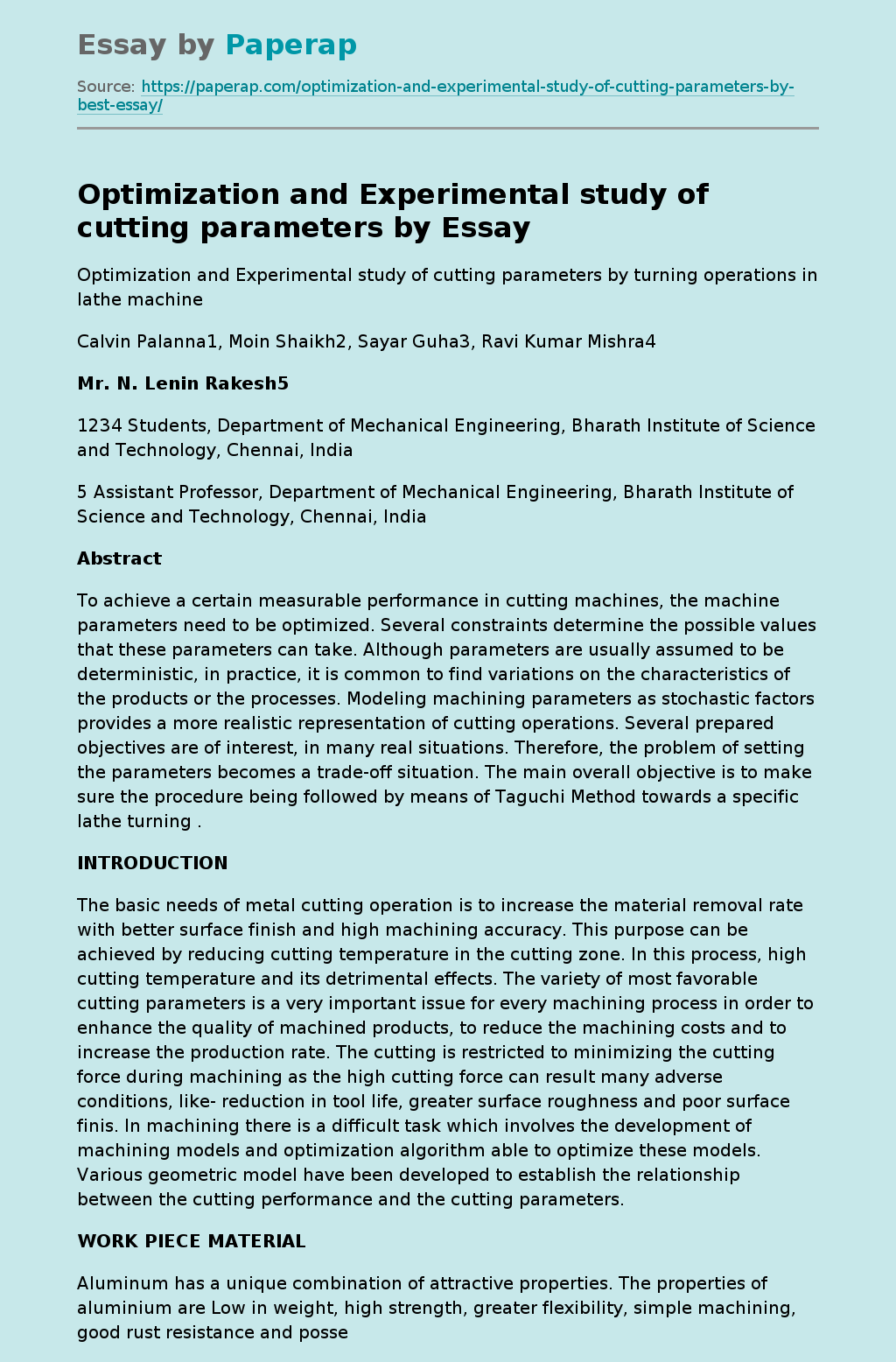Optimization and Experimental study of cutting parameters by
Optimization and Experimental study of cutting parameters by turning operations in lathe machine
Calvin Palanna1, Moin Shaikh2, Sayar Guha3, Ravi Kumar Mishra4
Mr. N. Lenin Rakesh5
1234 Students, Department of Mechanical Engineering, Bharath Institute of Science and Technology, Chennai, India
5 Assistant Professor, Department of Mechanical Engineering, Bharath Institute of Science and Technology, Chennai, India
Abstract
To achieve a certain measurable performance in cutting machines, the machine parameters need to be optimized. Several constraints determine the possible values that these parameters can take.
Although parameters are usually assumed to be deterministic, in practice, it is common to find variations on the characteristics of the products or the processes. Modeling machining parameters as stochastic factors provides a more realistic representation of cutting operations. Several prepared objectives are of interest, in many real situations. Therefore, the problem of setting the parameters becomes a trade-off situation. The main overall objective is to make sure the procedure being followed by means of Taguchi Method towards a specific lathe turning .
INTRODUCTION
The basic needs of metal cutting operation is to increase the material removal rate with better surface finish and high machining accuracy. This purpose can be achieved by reducing cutting temperature in the cutting zone. In this process, high cutting temperature and its detrimental effects. The variety of most favorable cutting parameters is a very important issue for every machining process in order to enhance the quality of machined products, to reduce the machining costs and to increase the production rate. The cutting is restricted to minimizing the cutting force during machining as the high cutting force can result many adverse conditions, like- reduction in tool life, greater surface roughness and poor surface finis.
In machining there is a difficult task which involves the development of machining models and optimization algorithm able to optimize these models. Various geometric model have been developed to establish the relationship between the cutting performance and the cutting parameters.
WORK PIECE MATERIAL
Aluminum has a unique combination of attractive properties. The properties of aluminium are Low in weight, high strength, greater flexibility, simple machining, good rust resistance and possess good thermal and electrical conductivity.
? TOOL MATERIAL
High-speed steel (HSS) is used as the cutting tool material. It is a subset of tool steels, commonly used in tool bits and cutting tools.
TAGUCHI TECHNIQUE
Quality is often approached to as conformance to specifications. This technique proposes different view of quality as one that relates it to cost and loss in money, not just to the manufacturer.At the time of production but to the consumer, to the society . This technique tells the loss is usually thought of as additional manufacturing cost incurred. Till the the point the product is shipped. In machining where as the energy inspired or the power demand varies due to noise variables which are classified as inner, outer and between product noises. Hence in order to decrease the effects caused by these noise variables, some contradict trials may be measured.
Here it is generally used in the examination of comparative studies, only the difference in outcomes is of interest. The statistical implication of the experiment is determined by a ratio of two variances. This ratio is self governing of several probable alterations to the experimental interpretation. Calculating a invariable to all interpretation does not revise implification. The results are independent of constant bias and scaling errors as well as the units used in expressing observations.
RESULTS AND CONCLUSION
? Cutting Speed
1. The harder the work material, the slower thecutting speed.
2. The softer the work material the faster the recommended cutting speed.
3. The harder the cutting tool material, the faster the cutting speed.
4. If the cutting speed is too slow than a lot of time is wasted during the machine process but if the cutting is too fast than also time is wasted in replacing or regrinding the cutters so the process should be carried out with an optimum cutting speed.
Optimization and Experimental study of cutting parameters by. (2019, Nov 22). Retrieved from https://paperap.com/optimization-and-experimental-study-of-cutting-parameters-by-best-essay/

